On the second day of my visit to Petra, I started with a detailed sightseeing of the Royal Tombs that are located on the west side of the rocky Jabal al-Khubtha massif. These are four impressive facades that were given this joint name. In order to reach these facades/tombs, you need to go a little uphill from the main visitor path. Nothing dramatic, as far as the climbing is concerned, but the facades are truly fascinating. The first one you come across from the direction of the Siq, which is the farthest to the right when observed frontally, is the Urn tomb.
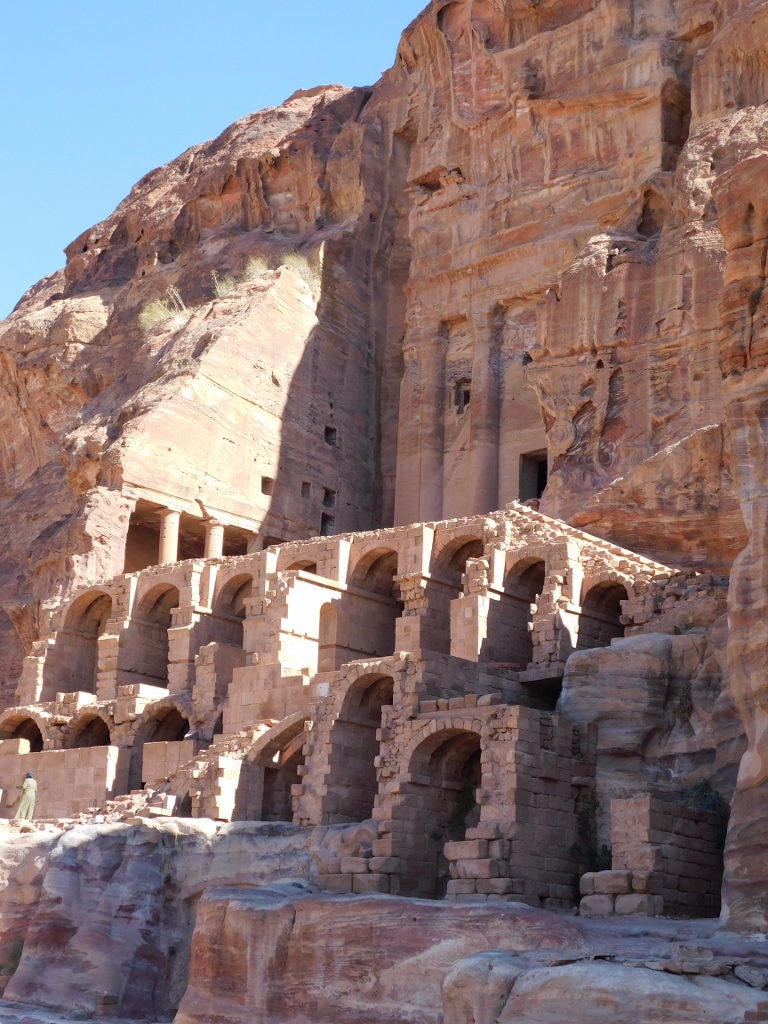 Petra, Urn Tomb
Petra, Urn Tomb
It is not known exactly who this tomb, that is by many aspects unique in Petra, was made for, but it is presumed, bearing in mind its grandeur, as well as the very striking position, that it was the final resting place of somebody very important. Most often, the sources mention Nabataean King Malichus II, since he died in 70 CE when the tomb was made.
The previous photo shows some of the important elements: up and on the right it is possible to see parts of the complex facade, left from there, lit by the Sun, it is possible to see a colonnade that flanks a courtyard in front of the tomb which is therefore called the colonnaded courtyard, and underneath all of that there is a substructure with numerous vaults.
To start with, when you approach the structure, you cannot actually see it as a whole that well, simply because you are too close. There are certainly some good points from which it would be possible to take good photos of the Urn Tomb, but I am not a professional photographer after all who was here on an assignment, so the next photo that I had taken the previous afternoon is the best among my photos while showing only the Urn Tomb. As for the whole group of the Royal Tomb, the best photos of them, as a group, can be seen in part 27 of the stories from my journey around Jordan in January 2022.
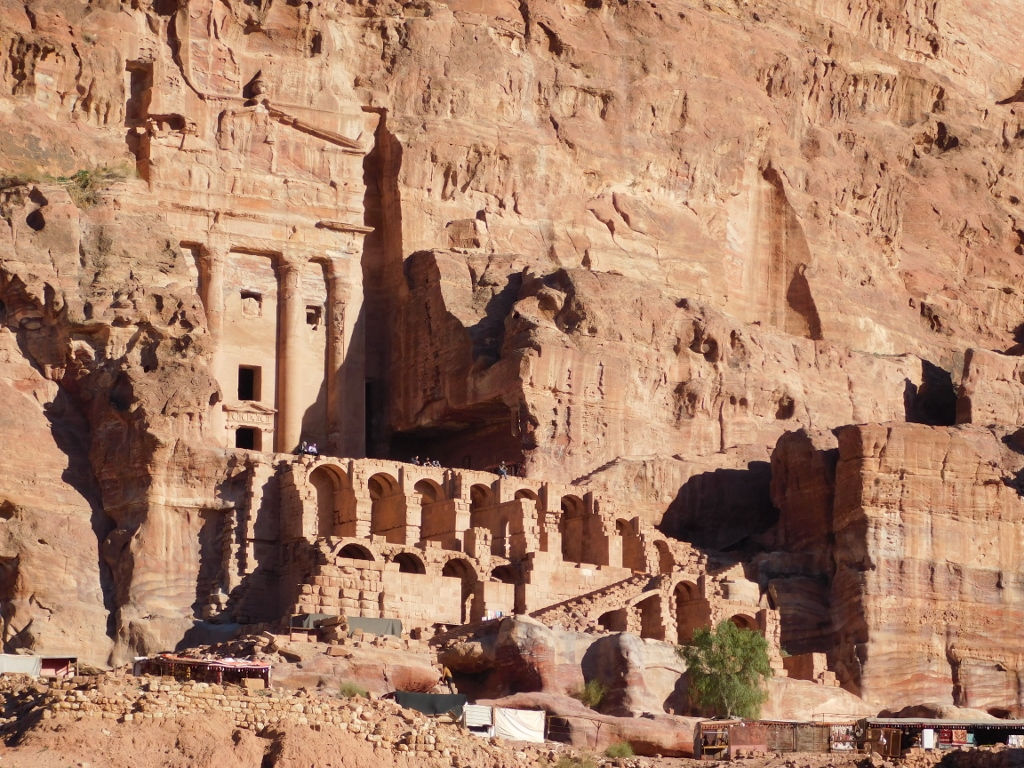 Petra, Urn Tomb
Petra, Urn Tomb
Since it can be seen well in both of the previous photos, let me say that the Urn Tomb got its name after the urn that decorates the top of the tomb’s facade and that is placed in the middle of the pediment.
As it can also be noticed in the photo above, in front of the facade carved in the cliff, the Urn Tomb has a plateau, i.e., the colonnaded courtyard. Below this plateau, there is the substructure made at two levels and consisting of a sequence of open chambers with barrel vaults. Since I first got to the substructure, let me start with that.
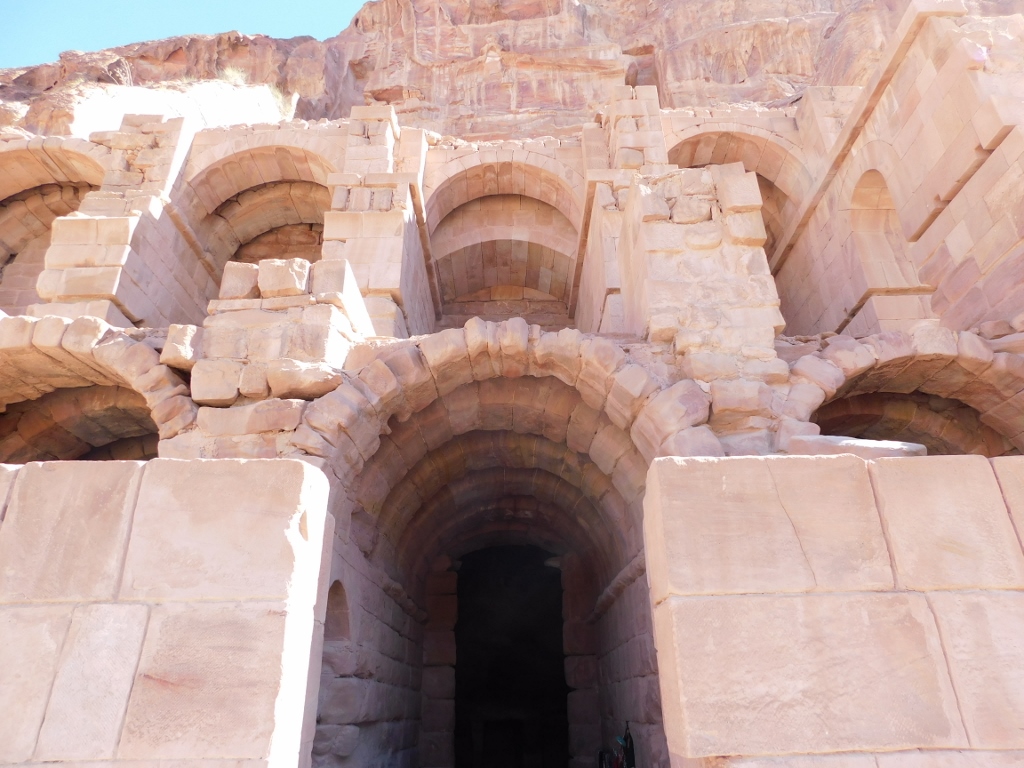 Petra, Urn Tomb, a detail from the substructure
Petra, Urn Tomb, a detail from the substructure
Although some segments of this lower part of the overall structure were also carved in the rock, most of it was built using stone blocks.
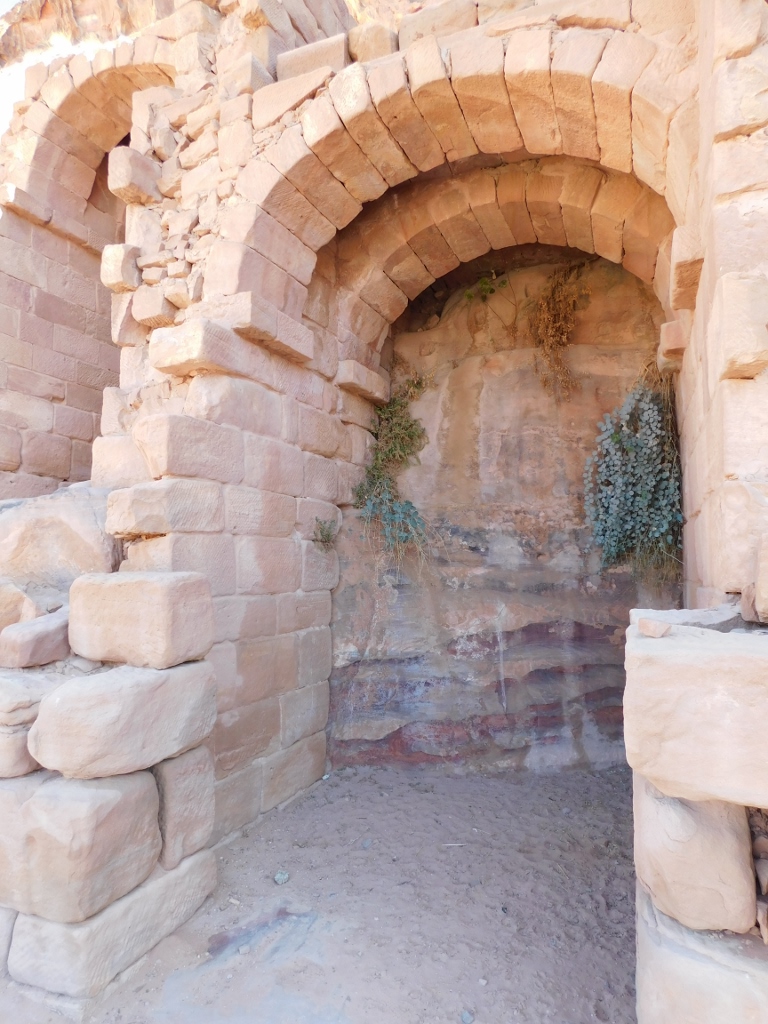 Petra, Urn Tomb, a detail from the substructure
Petra, Urn Tomb, a detail from the substructure
There are different opinions among the researchers as regards the time of the construction of the substructure. Some believe it was built at the same time as the tomb itself (around 70 CE), while others maintain that it was added in the 5th century. On the other hand, I could not find anywhere what the researchers think was the purpose of these premises in the substructure, but it appears that the Bedouins called this part “jail.” Whether these rooms were used in that way at some point in time remains uncertain, but it is known that many tomb facades in Petra, that are the main focus of the visitors, were merely a part of large burial complexes that often included courtyards, banquet rooms, etc.
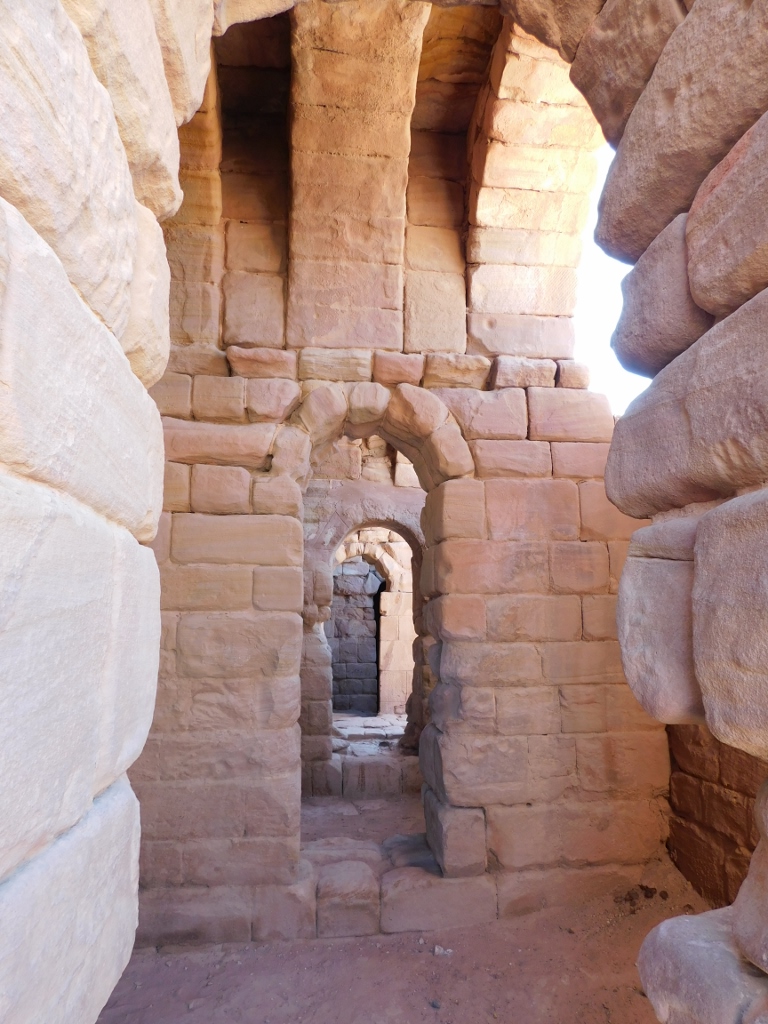 Petra, Urn Tomb, a detail from the substructure
Petra, Urn Tomb, a detail from the substructure
As for the Urn Tomb, I first roamed a little around the substructure and then following a wide staircase I went up to the courtyard in front of the tomb and its facade.
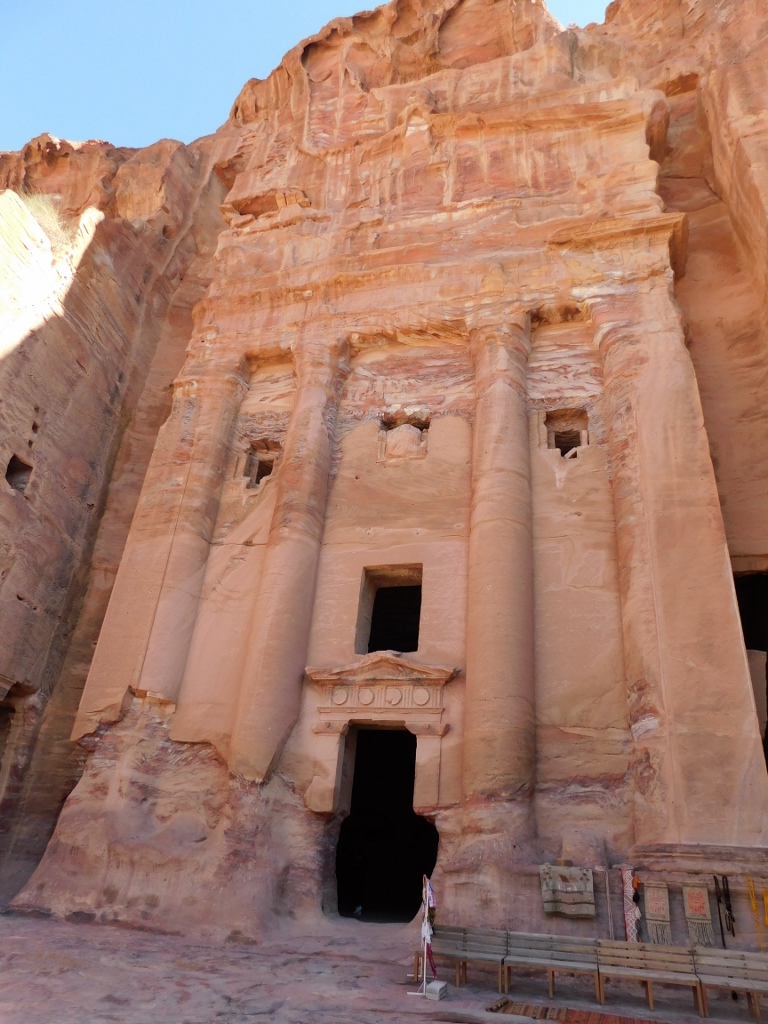 Petra, Urn Tomb
Petra, Urn Tomb
The facade of the Urn Tomb is 16.5 m wide and 26 m high. With its appearance the facade imitates the front facade of a temple and there are clearly visible influences of the Hellenism. The doorway is positioned in the middle between two tall half-columns, while on the “corners” there are two pilasters.
These columns and pilasters “carry” the upper zone of the facade. Although the entire facade is rather “smoothed out” today on account of the erosion, it is possible to recognise a frieze, smaller pilasters, as well as a pediment on the very top of which is the lidded urn carved out of the rock.
To the right from the facade, there is a chiselled out space, like a huge niche, that is nowadays used as a souvenir shop.
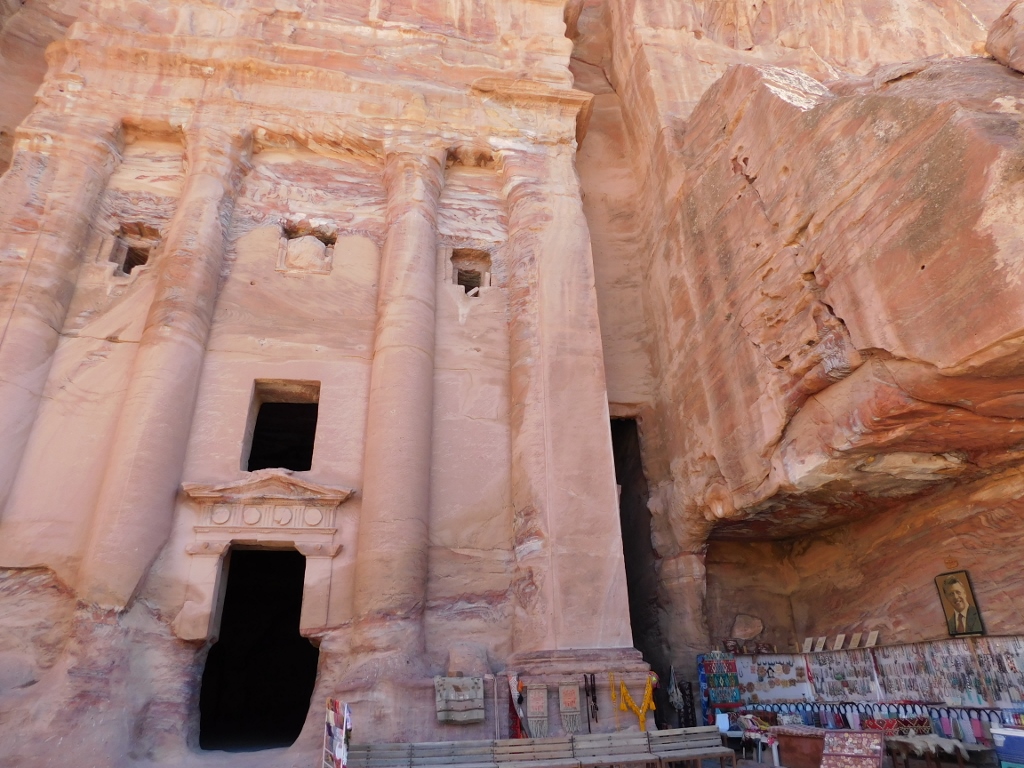 Petra, Urn Tomb
Petra, Urn Tomb
What is particularly interesting are three burial niches, the loculi, made towards the top of the fields between the half-columns and the pilasters. In the middle loculus, it is still possible to see the bust of a dignitary dressed in a toga, but nothing more than that. That is why it is not known who the tomb was actually made for.
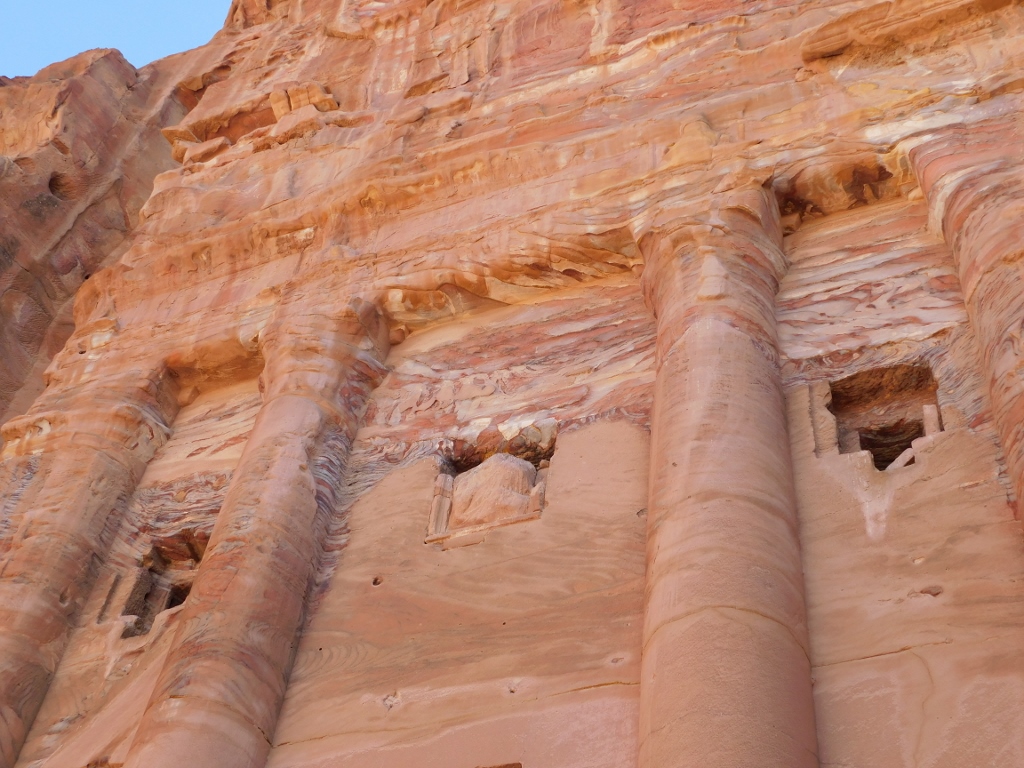 Petra, Urn Tomb, a detail
Petra, Urn Tomb, a detail
The tomb may be entered through the flanking doorways, but the central, main one is certainly most interesting. You can see nice stone decoration in the shape of pilasters with Nabataean capitals, as well as a frieze and a pediment. The opening seen above the doorway was made during the Byzantine times when the tomb was used as a church. More concretely, the tomb was turned into a church in 446 CE.
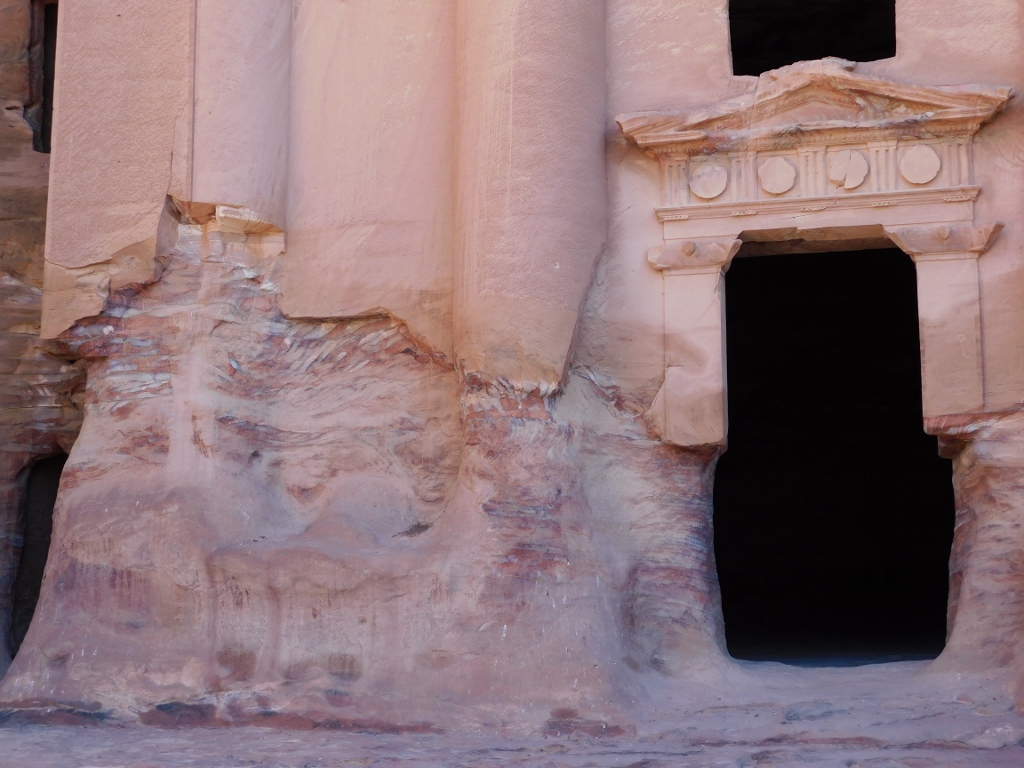 Petra, Urn Tomb, a detail
Petra, Urn Tomb, a detail
What I found additionally fascinating were the rocks, especially the rough segments, exposed over time by the action of the erosion, because these places reveal their stunning appearance. I have already mentioned this in the previous sequel of my stories and this can also be noticed in a couple of photos above. Still, here is another one below. I don’t know what geologists have to say, but this zebra-patterned, red and white rock with purple, bluish or gray details is absolutely mesmerising.
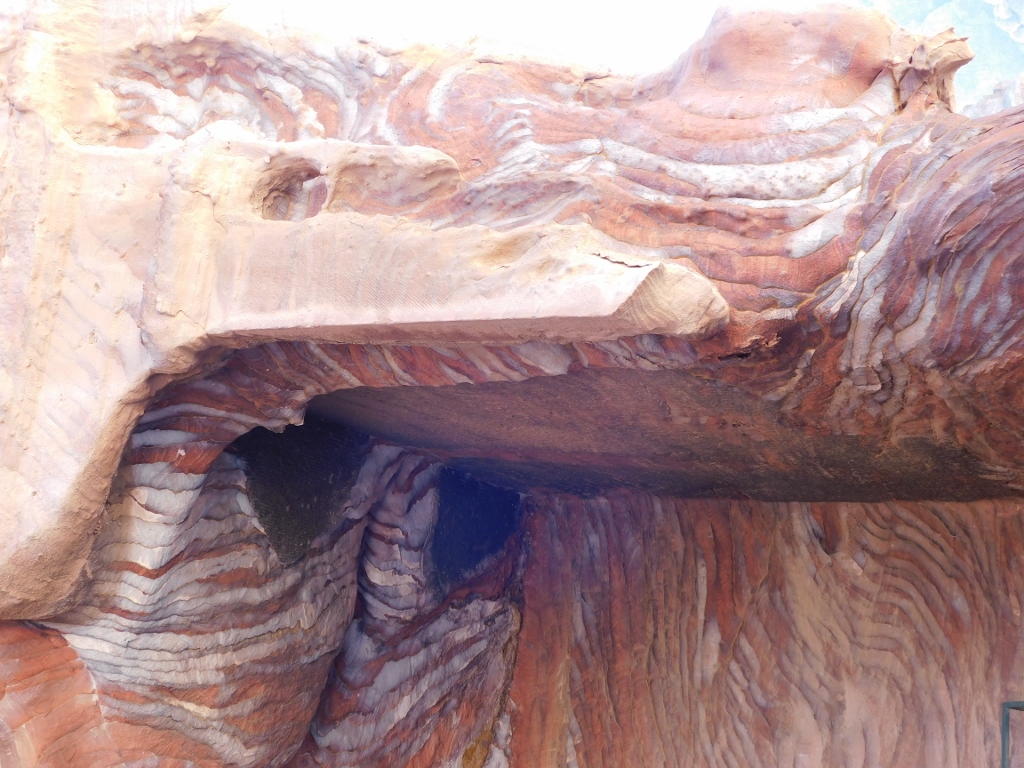
Petra, Urn Tomb, a detail
Before I entered the Urn Tomb, I first enjoyed the view at the site of Petra that can be seen from here and is considered to be one of the best. In the following photo, on the left-hand side, you can discern the Theatre in the shade. Then, there is the wide visitor path which in the right-hand side of the photo turns left, i.e., towards the very centre of Petra.
 Petra
Petra
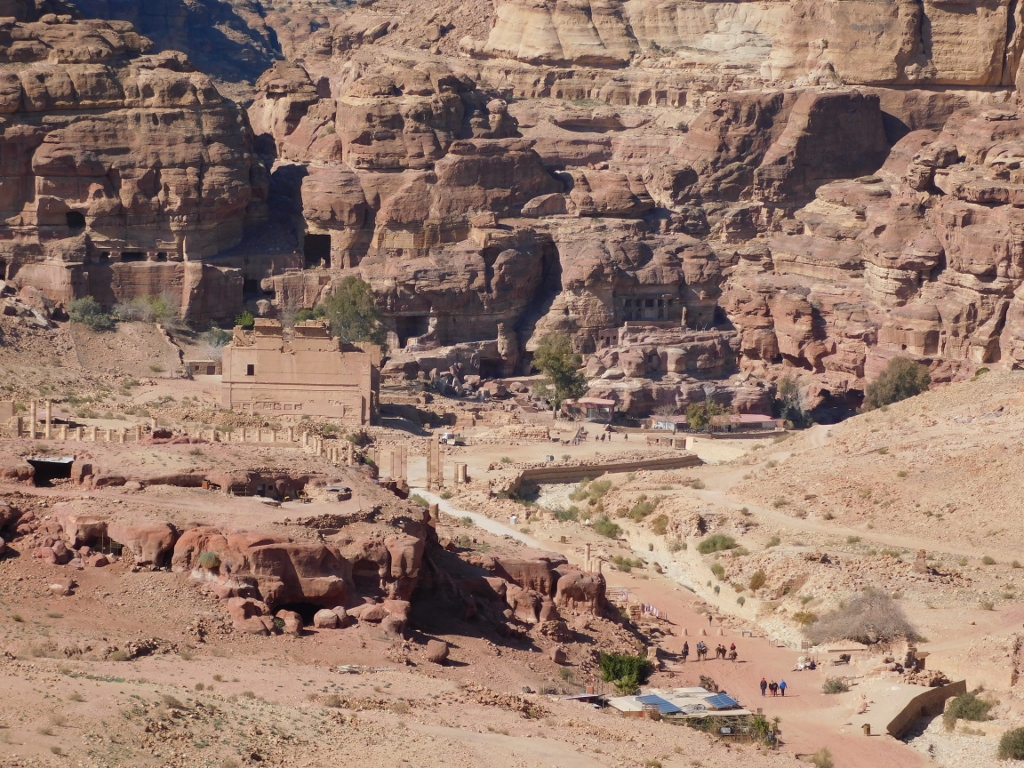 Petra centre
Petra centre
The interior of the tomb is quite simple. It’s a large room with an almost square ground plan, of the approximate size of 20 m x 17 m.
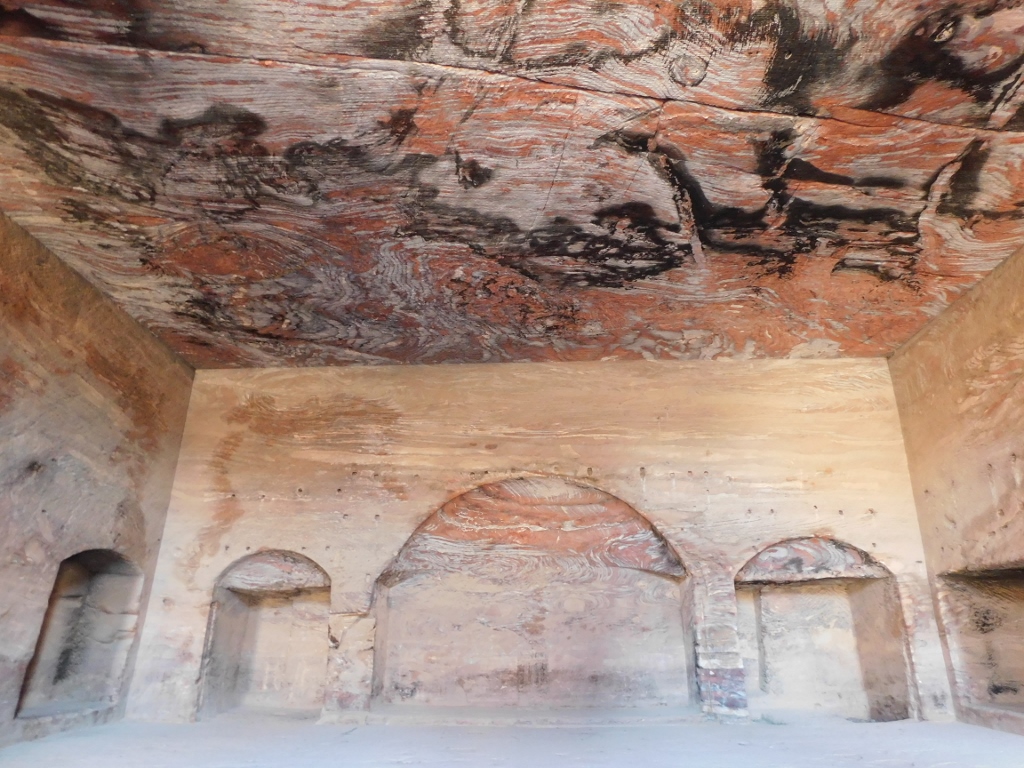 Petra, Urn Tomb, the interior
Petra, Urn Tomb, the interior
When the tomb was turned into a church, and it is also possible that it served as the cathedral on account of its pronounced position, the niches in the back wall were turned into apses. On the back wall, all the way to the left, it is possible to see an inscription that says that the change of the function of this room was carried out by Bishop Jason in 446.
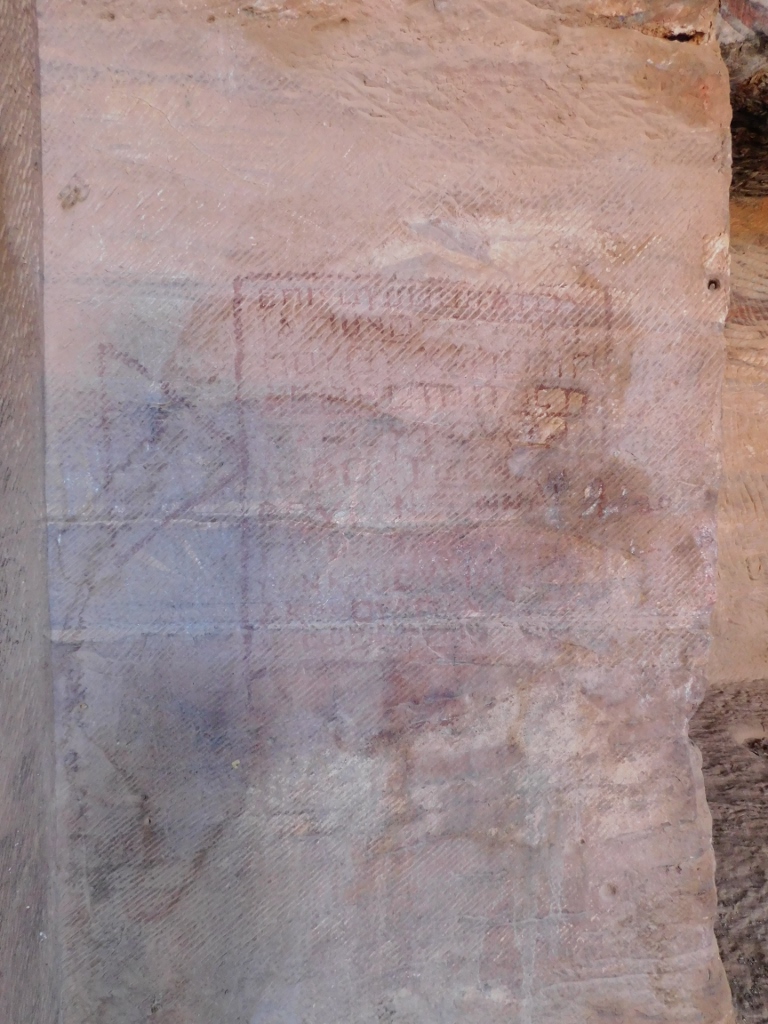 Petra, Urn Tomb, a detail
Petra, Urn Tomb, a detail
Regardless of the height of the Urn Tomb’s facade, this room is only as high as the level of the second row of the openings. This is seen nicely when you are inside and look towards the entrance.
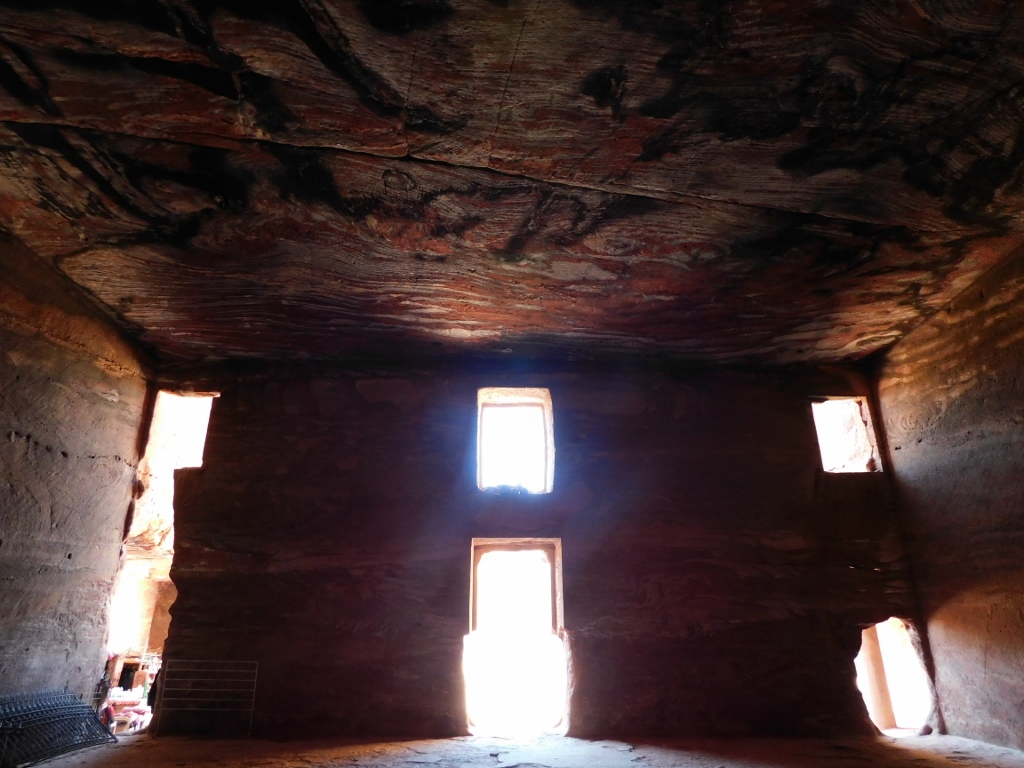 Petra, Urn Tomb, a detail
Petra, Urn Tomb, a detail
What I found utterly amazing here again was the ceiling, that is, the rocks that constitute the ceiling and their colours.
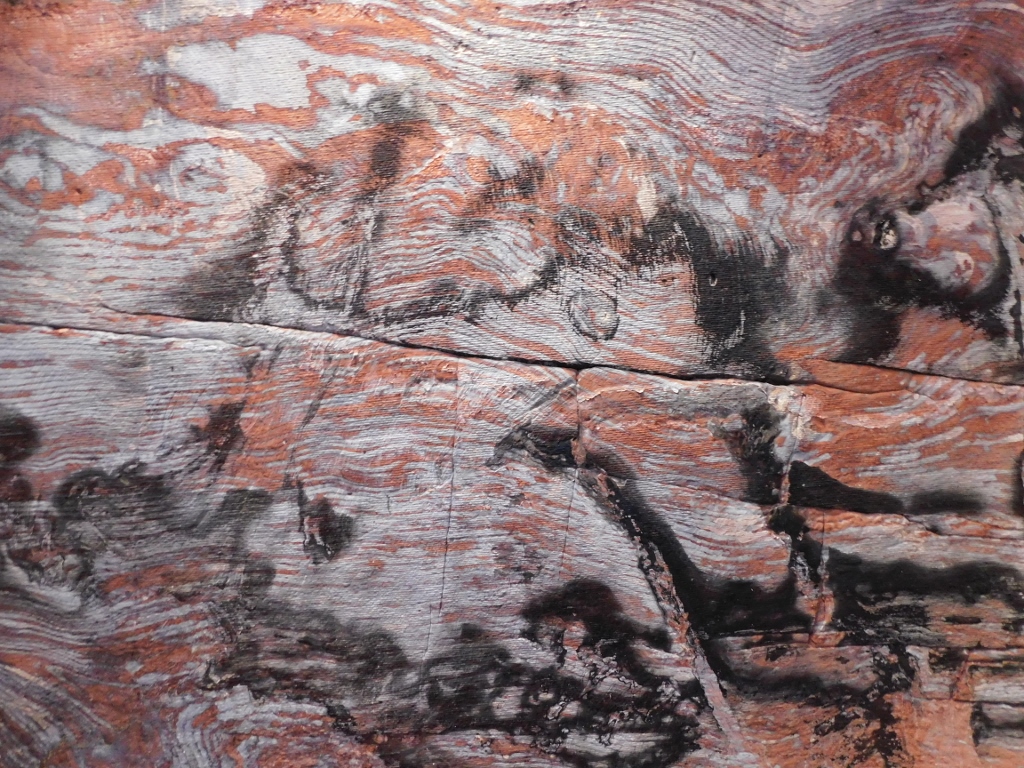 Petra, Urn Tomb, a detail
Petra, Urn Tomb, a detail
The acoustics in this room were also perfect and as I was completely alone, I gave myself a short concert. But, I didn’t want to record this, because after all, it was not meant for others. But, I enjoyed it thoroughly!
In front of the Urn Tomb there is that courtyard that I have mentioned and, when you look frontally at the facade, on the left-hand side of the courtyard there are five columns, each being around 4.5 m high, while behind them is a porch-like space. The same situation used to exist on the right-hand side, but the columns were eventually destroyed by the erosion and now there is only space that resembles a large niche there (this can be seen in one of the previous photos).
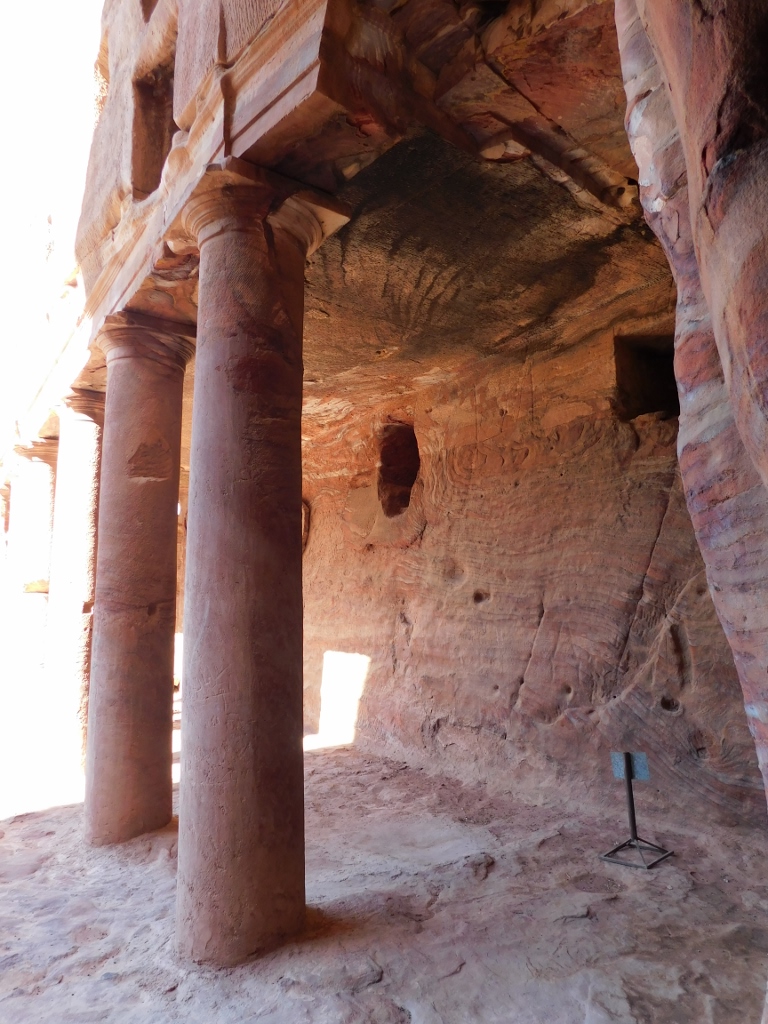 Petra, Urn Tomb, a detail
Petra, Urn Tomb, a detail
In the cliff above the columns there are four loculi and one shallow niche. One of these “openings” may be seen in the photo above, right up from the carved architrave carried by the columns.
So, here I finished with the visit to the Urn Tomb and then I descended down the stairs to the lower level, looking once again at the chambers with vaults and the upper zone of the facade on the top of which it was possible to see quite clearly the rock urn that gave the name to this tomb.
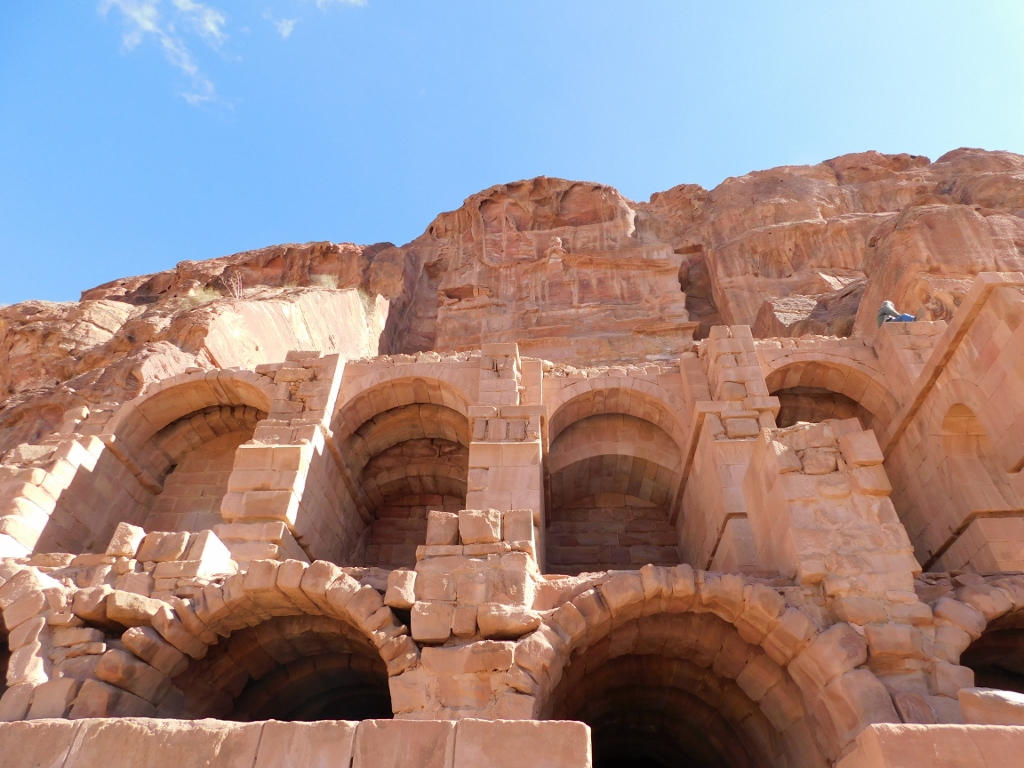 Petra, Urn Tomb
Petra, Urn Tomb
The next important tomb within the Royal Tombs group in Petra is the Silk Tomb. In the following photo, it is the one to the left.
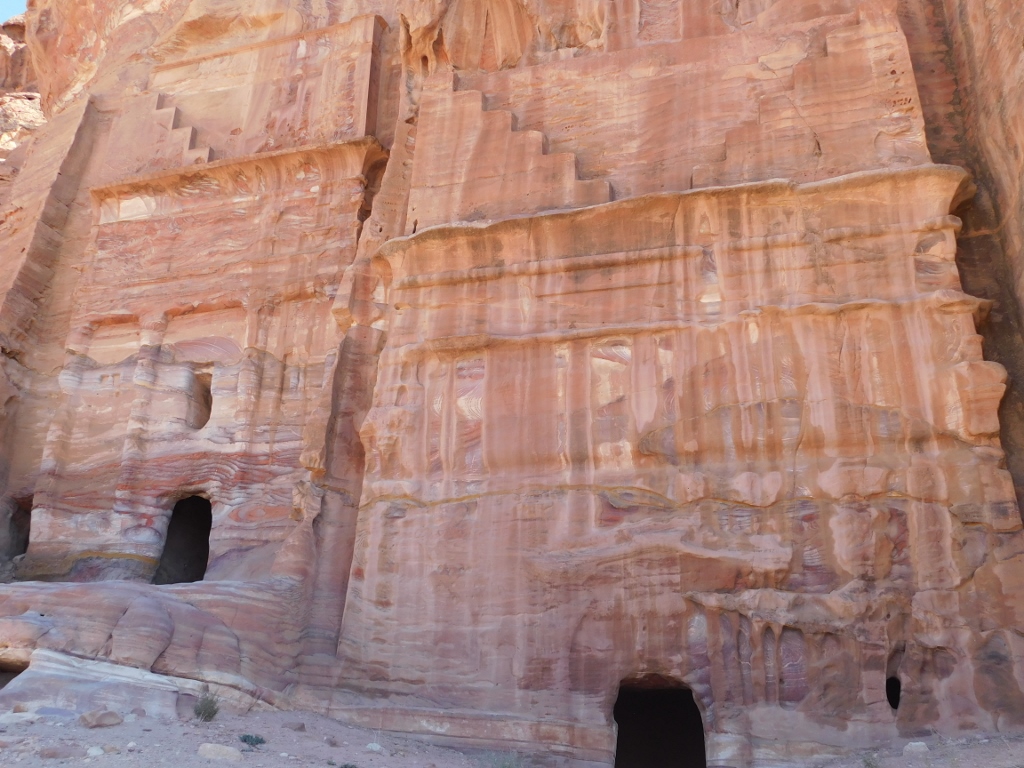 Petra, Silk Tomb, left
Petra, Silk Tomb, left
This tomb, that is often called the Streaked Tomb, got its name because of the intensive and extraordinarily beautiful iridescent stripes that can be seen on the eroded sandstone and that reminded the early archaeologists of moire (a type of silk fabric).
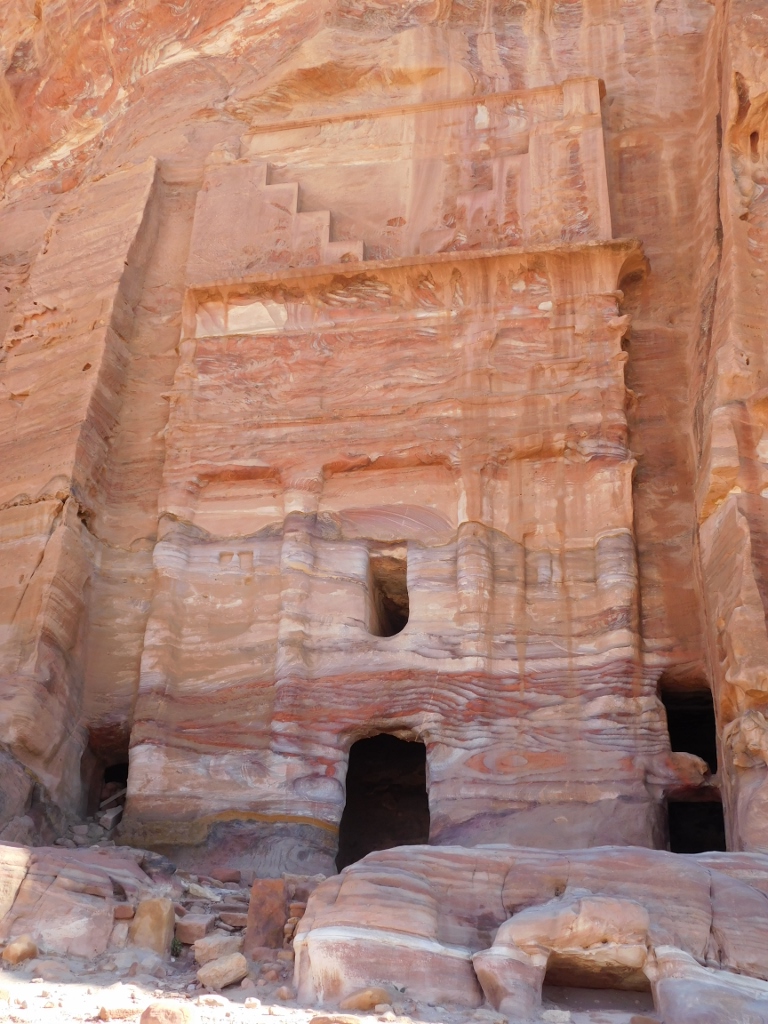 Petra, Silk Tomb
Petra, Silk Tomb
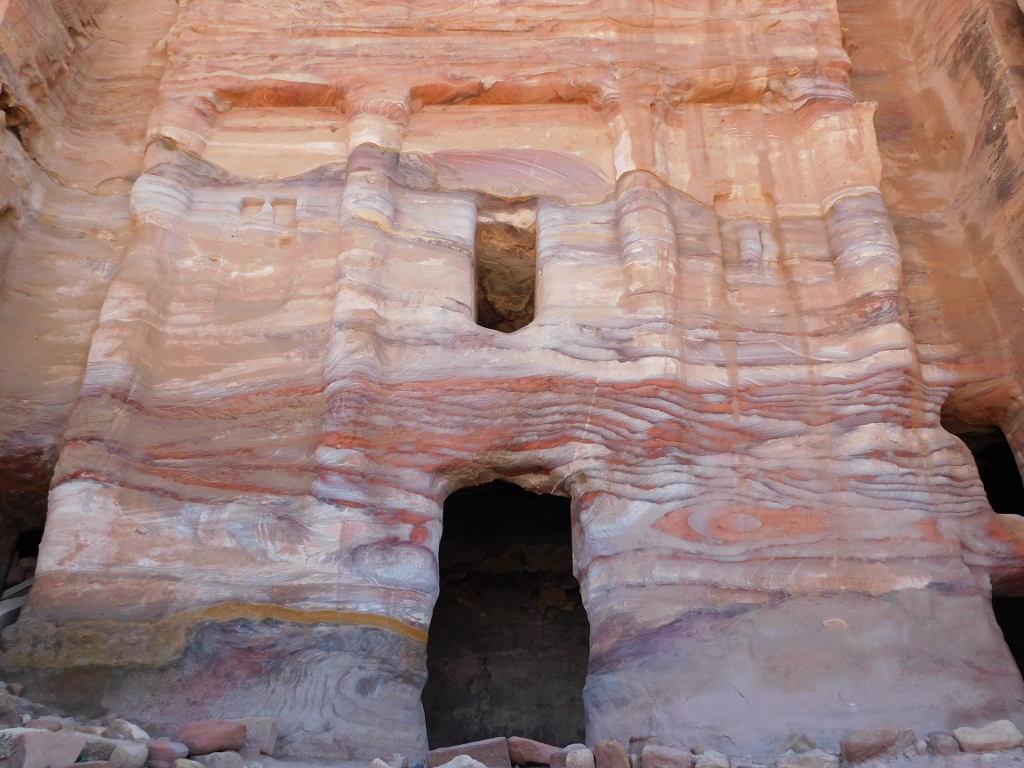 Petra, Silk Tomb, a detail
Petra, Silk Tomb, a detail
The tomb was made in the Hegra style. In the lower zone there is a doorway which the researchers believe was not decorated and above it there is a loculus, i.e., a burial niche. Regardless of the intensive erosion, it is still possible to discern half-columns on the facade, as well as a couple of shallow niches with relief figures that are located in the fields between the outer columns.
Above the lower zone comes the middle zone with the slight remains of pilasters, while the upper zone has a frieze consisting of two segments with five steps each placed to face one another, which is an element that can often be found on the tombs in Petra.
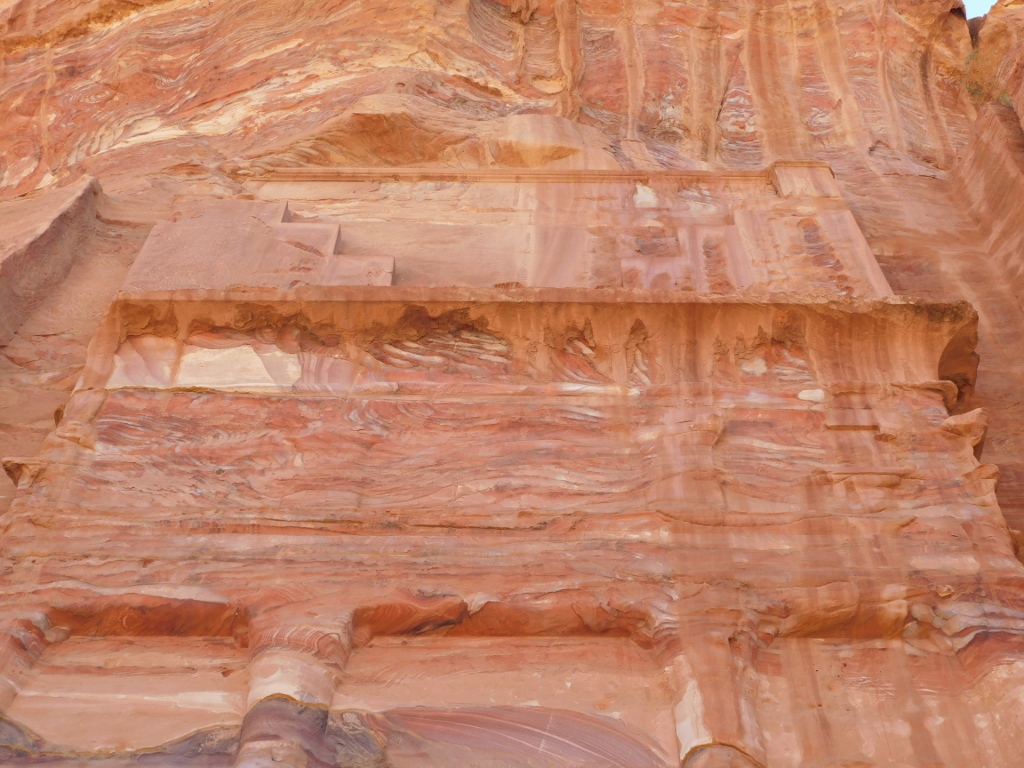 Petra, Silk Tomb, a detail
Petra, Silk Tomb, a detail
The interior of the Silk Tomb has no significant elements.
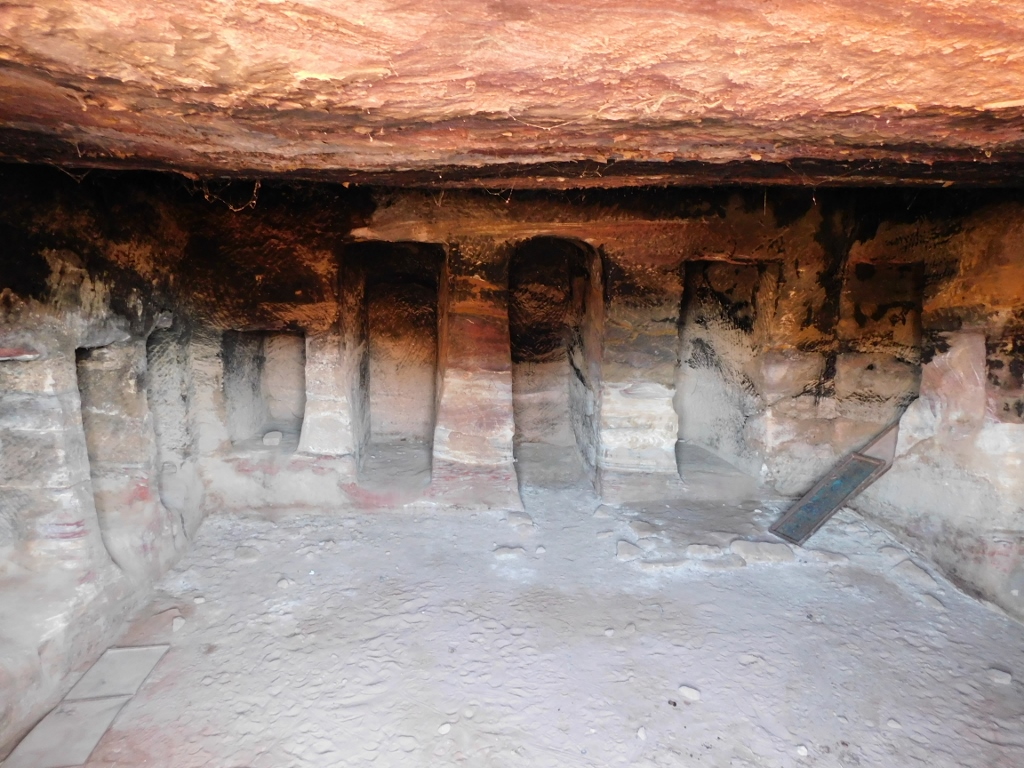 Petra, Silk Tomb, a detail
Petra, Silk Tomb, a detail
When you stand in front of the Silk Tomb, you can again enjoy the impressive view at the central parts of Petra.
 Petra
Petra
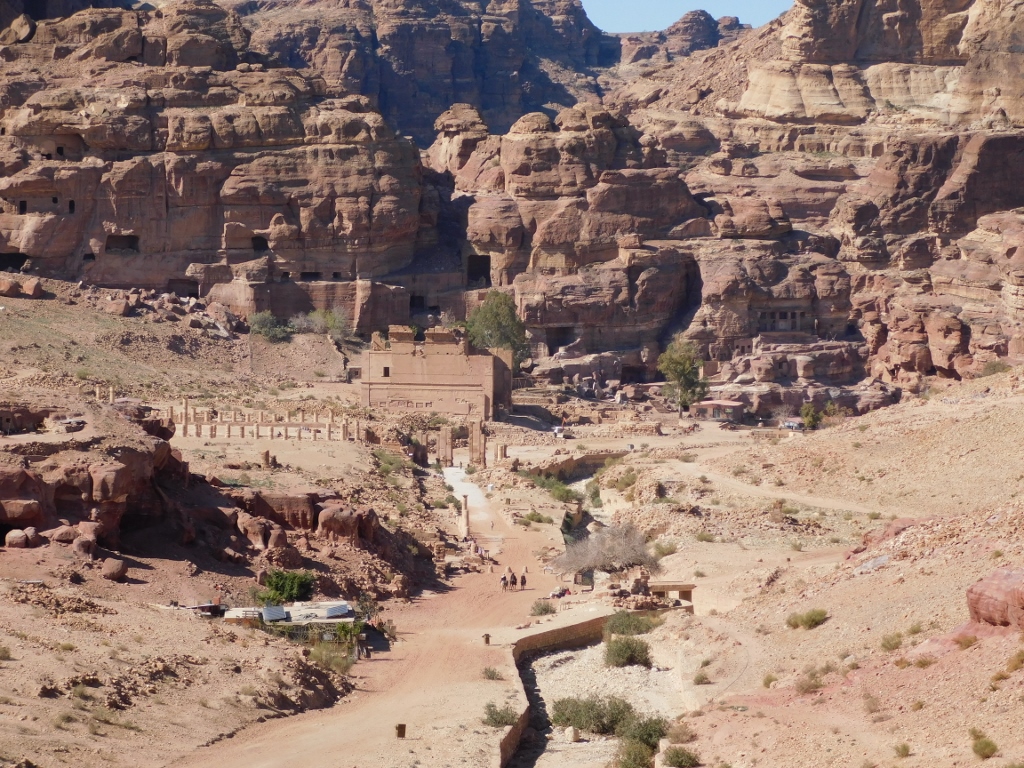 Centre of Petra
Centre of Petra
I just continued with my visits to the Royal Tombs and the next one was the Corinthian Tomb.
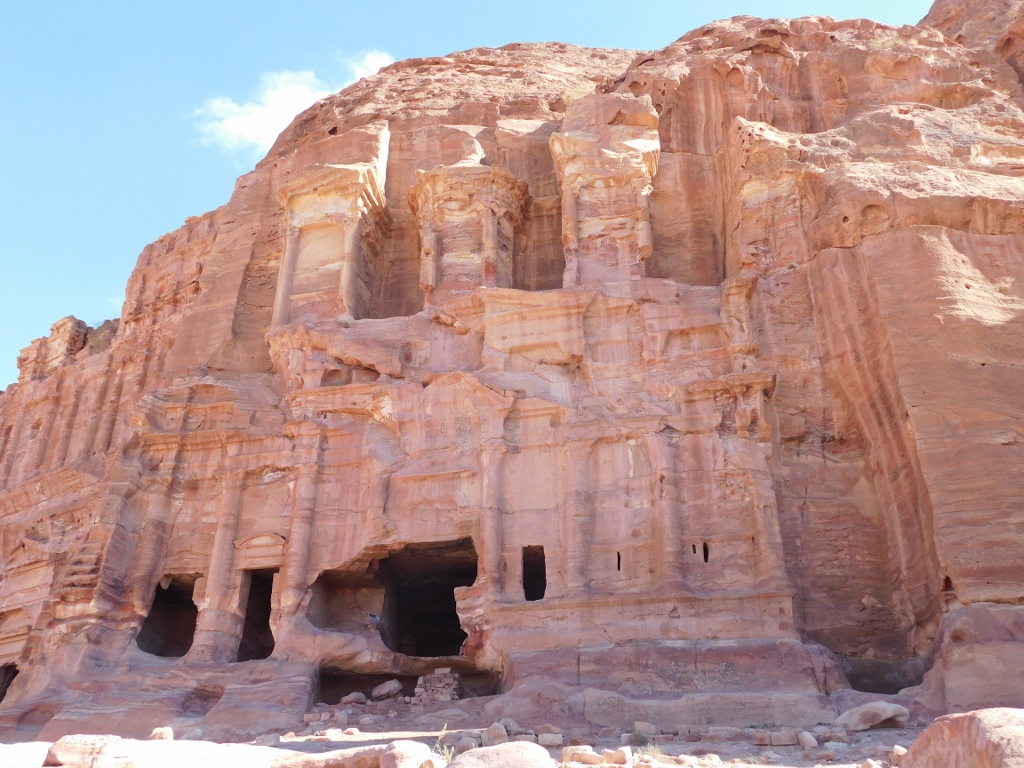 Petra, Corinthian Tomb
Petra, Corinthian Tomb
The facade of this tomb (made in 40-70 CE) is partially reminiscent of al-Khazneh or the Treasury and one of the first explorers gave it this name because of the capitals on the half-columns that can be seen on the facade. Later, it was concluded that these were in fact the Nabataean version of the Corinthian capitals. So, something in between at best.
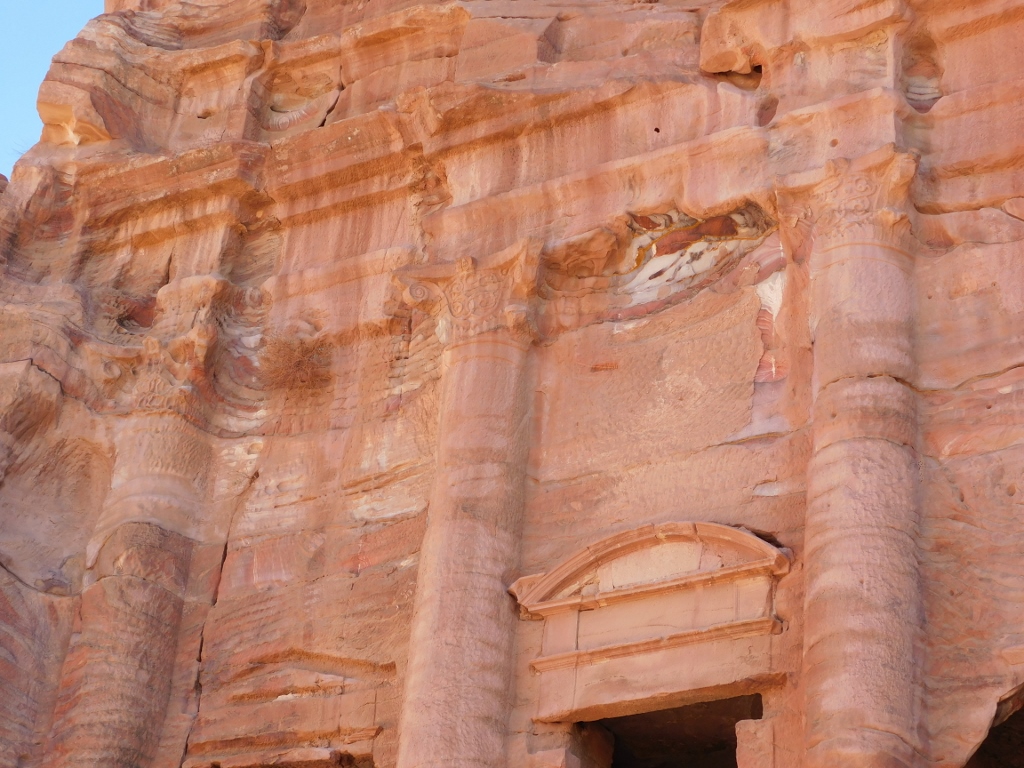 Petra, Corinthian Tomb, a detail
Petra, Corinthian Tomb, a detail
The facade, 27.5 m wide and 28 m high, consists of three zones. In the lower one, you can see eight half-columns, with the main doorway in the middle. The doorway has greatly deteriorated over time and in a way it has joined the side entrance to the left.
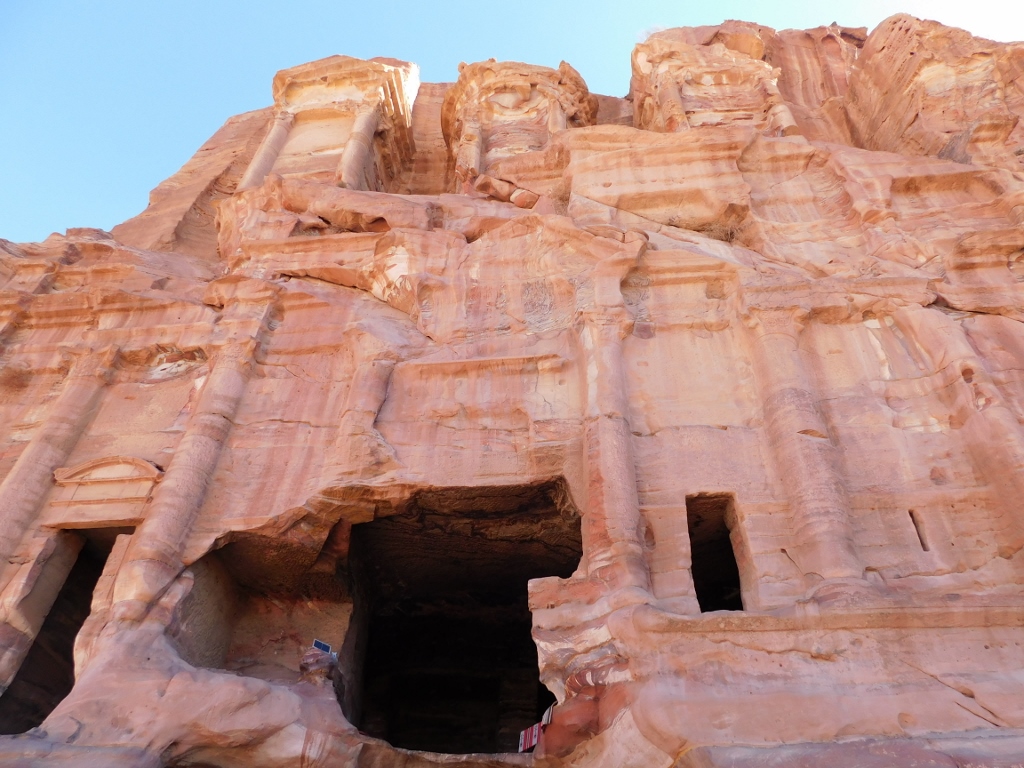 Petra, Corinthian Tomb, a detail
Petra, Corinthian Tomb, a detail
It is interesting that the facade is asymmetrical in the lower zone, meaning that left of the main doorway there are three side entrances (between the half-columns) each one of which leads into a separate smaller room. Right of the main doorway, in the fields between the half-columns, there are windows/openings of different size. They, together with the main doorway lead into a large chamber with recesses and a loculus.
The following photo shows the opening right of the main doorway, as well as a half-column with the Nabataean capital.
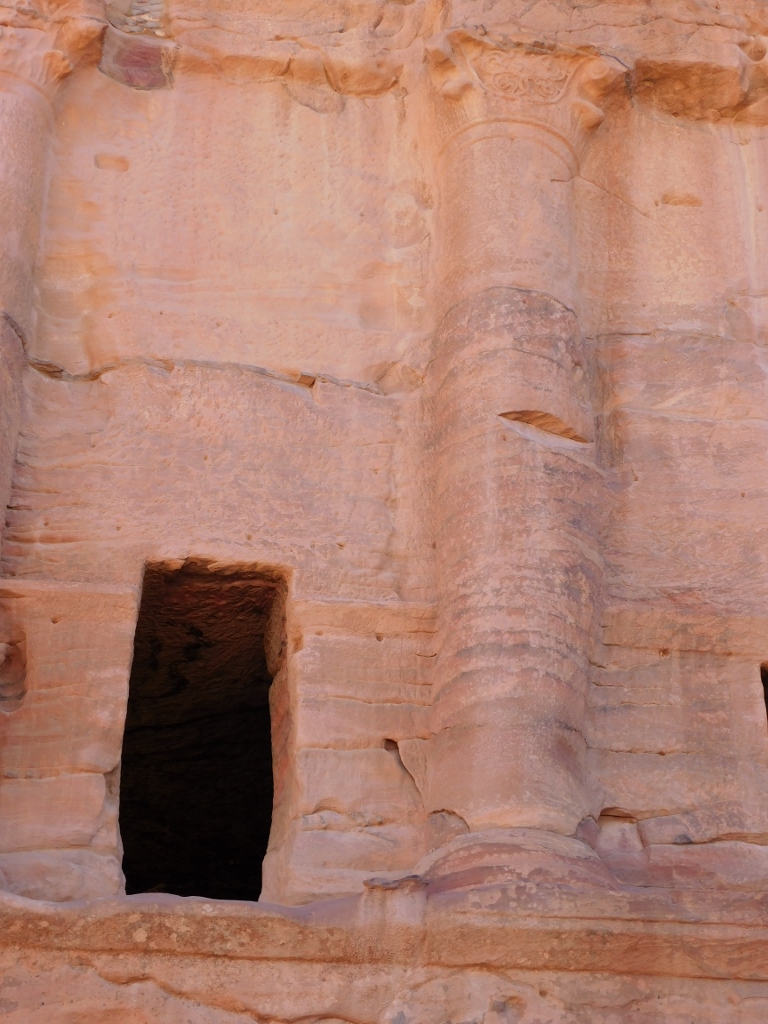 Petra, Corinthian Tomb, a detail
Petra, Corinthian Tomb, a detail
The facade’s middle zone has eroded significantly, but in places it is still possible to recognise clearly smaller pilasters, a cornice and other architectural elements.
The upper, third zone of the facade is strikingly reminiscent of al-Khazneh. One can clearly see the eroded parts here: a tholos in the middle and broken pediments to the left and right from it.
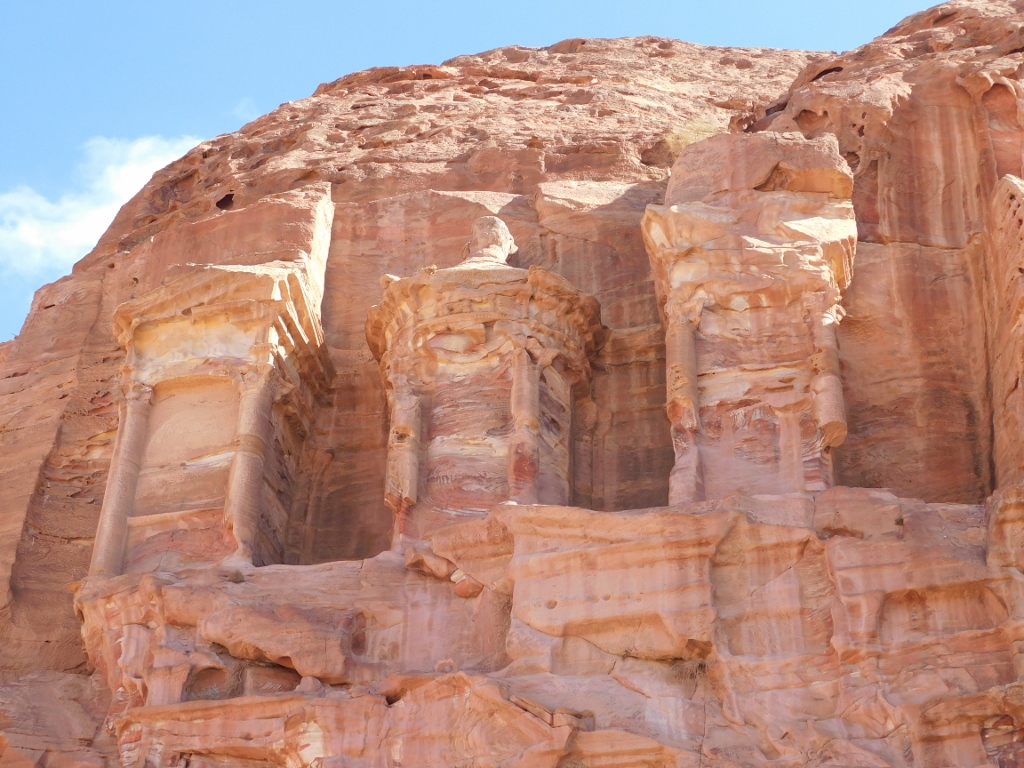 Petra, Corinthian Tomb, better preserved right-hand side of the middle zone and the upper zone
Petra, Corinthian Tomb, better preserved right-hand side of the middle zone and the upper zone
The next structure within the Royal Tombs group is the Palace Tomb.
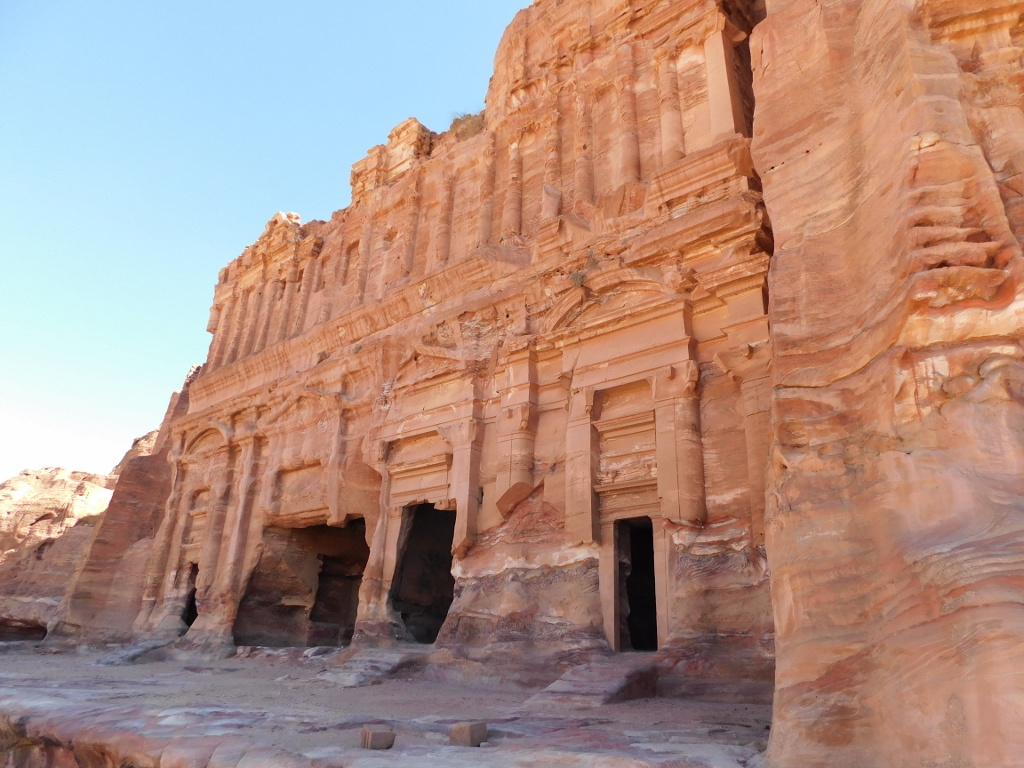 Petra, Palace Tomb
Petra, Palace Tomb
This tomb with complex facade, 49 m wide and almost 46 m high, is one of the biggest structures in Petra. The tomb’s facade is impressive enough, both because of the size and because the wealth of architectural elements created solely to serve as decoration, that it could easily be a part of a palace, so hence its name. In order to appreciate this better, here is a photo I took somewhat later, where it is possible to see nicely both the Palace Tomb and the Corinthian Tomb.
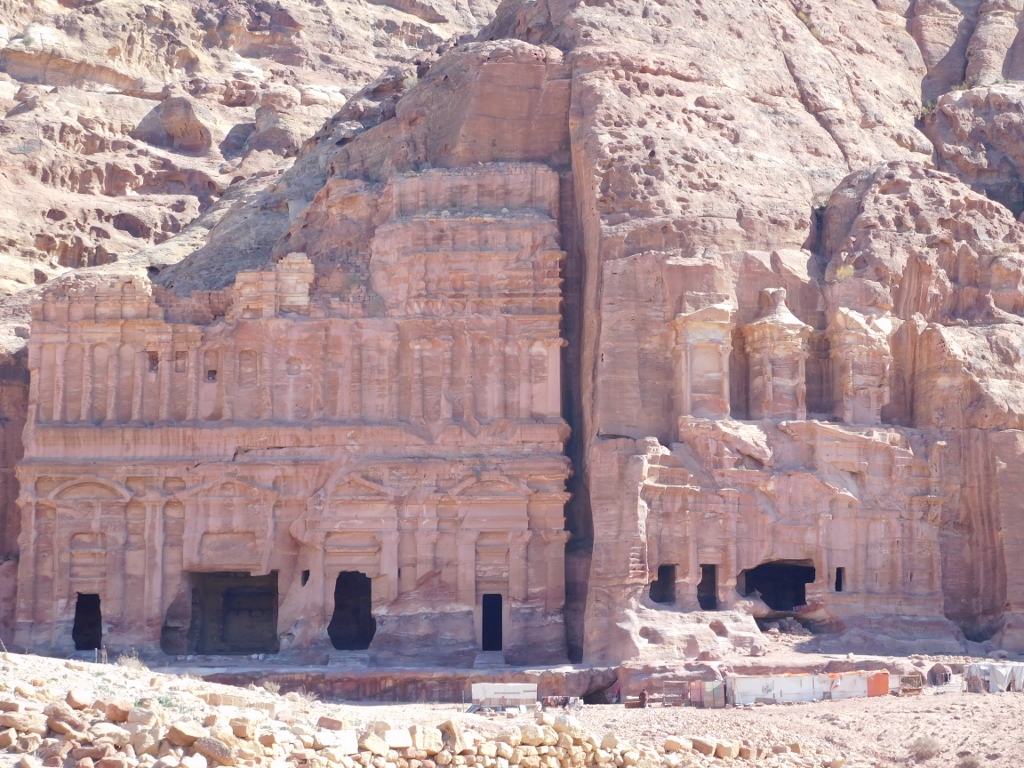 Petra, the Palace Tomb and the Corinthian Tomb
Petra, the Palace Tomb and the Corinthian Tomb
The facade of the Palace Tomb consists of five zones. Since it turned out during the making of this facade that the cliff was too short for its higher zones, there are some segments towards the top that were not carved out of the rock, but were rather made of stone blocks. Of course, a lot has collapsed over time. This can, however, also be seen in the previous photo: at the level of the third zone one can see two side segments with pilasters, while in between there are parts made of stone blocks.
At the same time, the right-hand sections of the facade are better protected against the action of the wind, so there are segments in which the sharp edges of the architectural and decorative elements have been preserved. For instance, in the case of the far right doorway seen in the photo below.
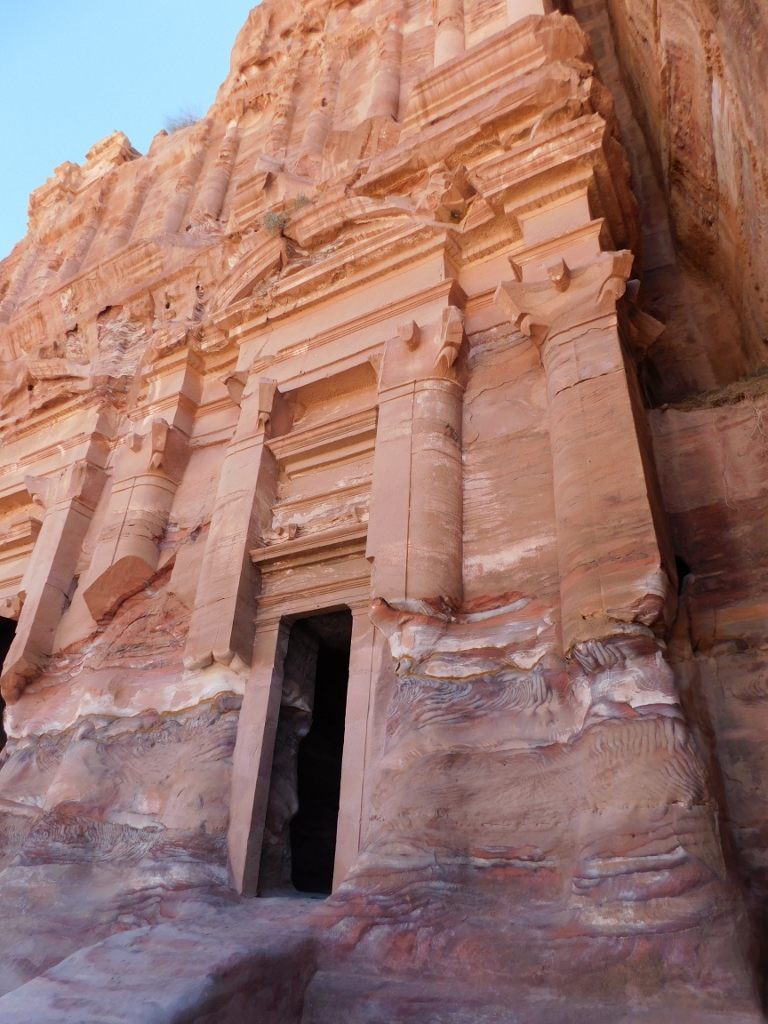 Petra, Palace Tomb, a detail
Petra, Palace Tomb, a detail
The Palace Tomb has four doorways distributed between pilasters topped by Nabataean capitals. It is precisely by these doorways that the adverse impact of the erosion can be seen well. The best preserved is the far right one (photo above), while the doorway in the poorest state of preservation is the second from the left where the wind significantly expanded the entrance into the chamber. Here are the photographs of the remaining three doorways. You can also see the remains of the rock access paths, parts of the remaining architectural elements and partially what the interior of the chambers within the tomb looks like.
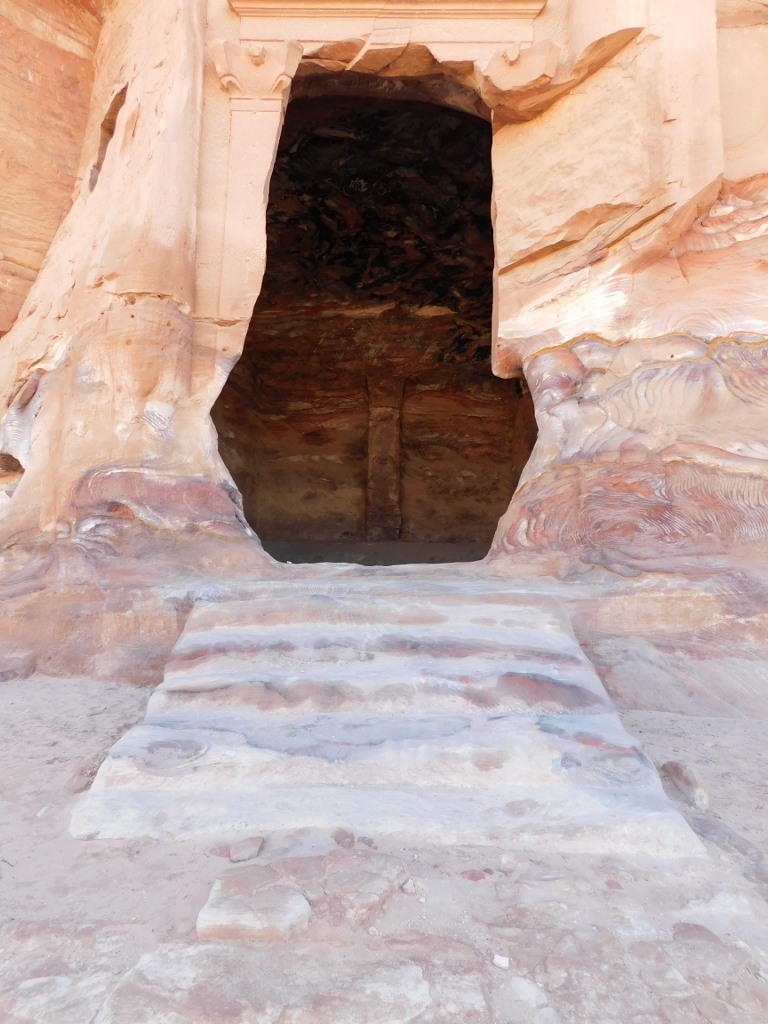 Petra, Palace Tomb, second entrance from the right
Petra, Palace Tomb, second entrance from the right
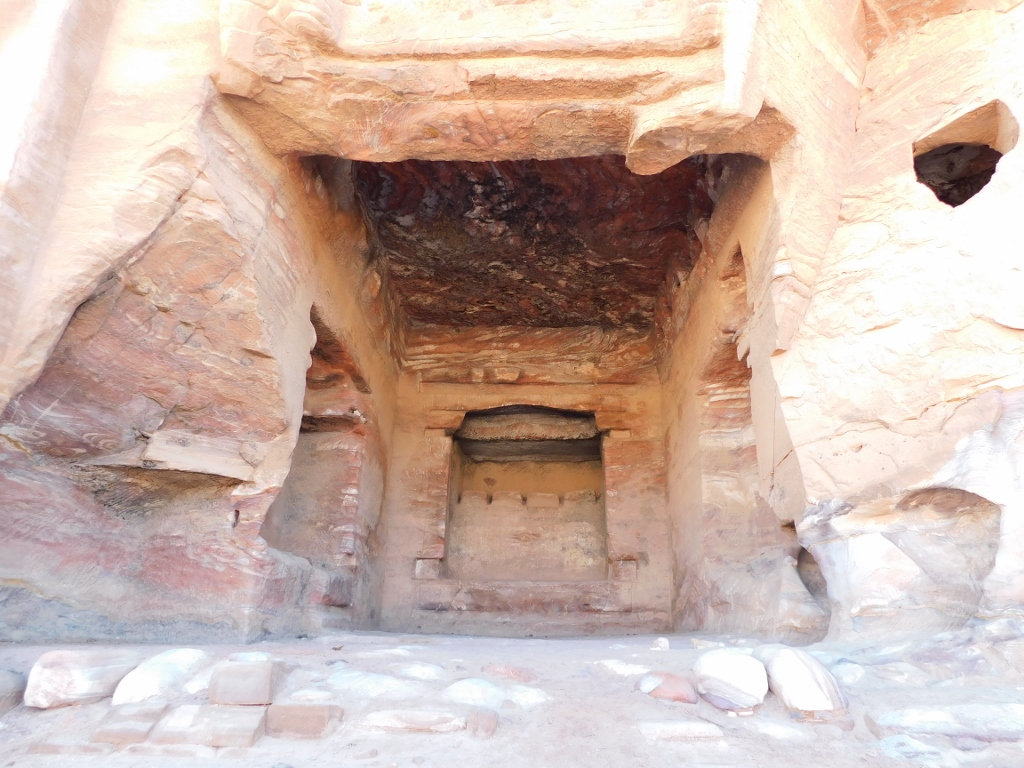 Petra, Palace Tomb, second entrance from the left
Petra, Palace Tomb, second entrance from the left
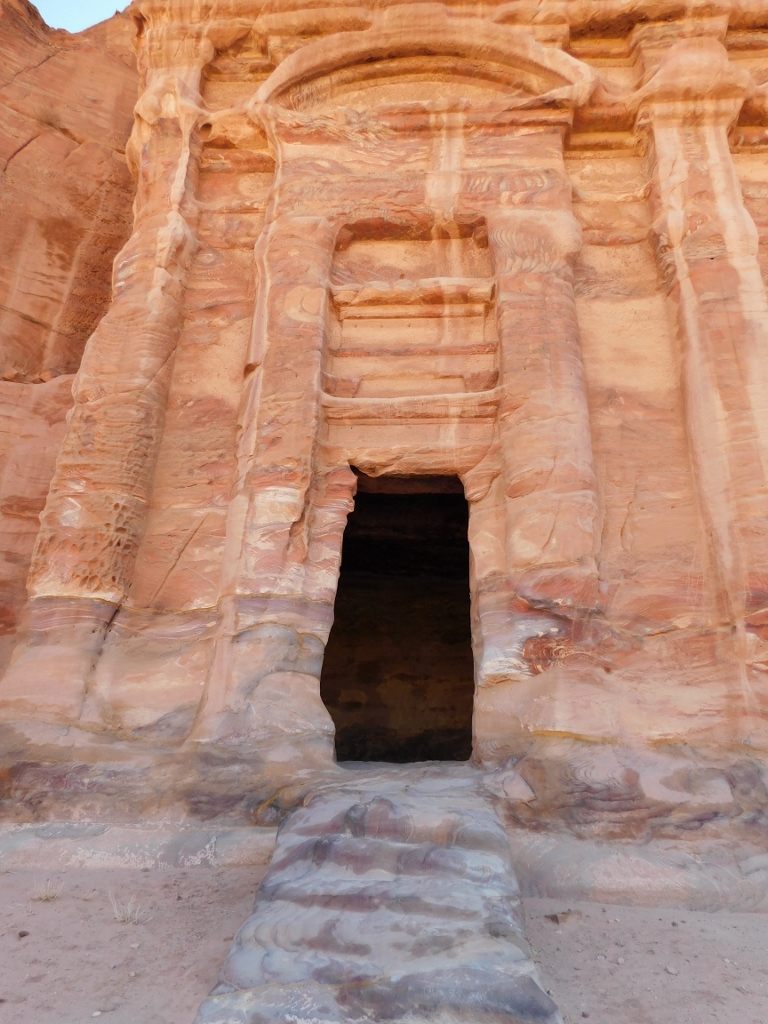 Petra, Palace Tomb, first entrance from the left
Petra, Palace Tomb, first entrance from the left
In the second zone, there is a sequence of low half-columns, the third zone contains dwarf pilasters, the fourth one has significantly decayed, while in the fifth zone only all the way to the right you can see seven half-columns.
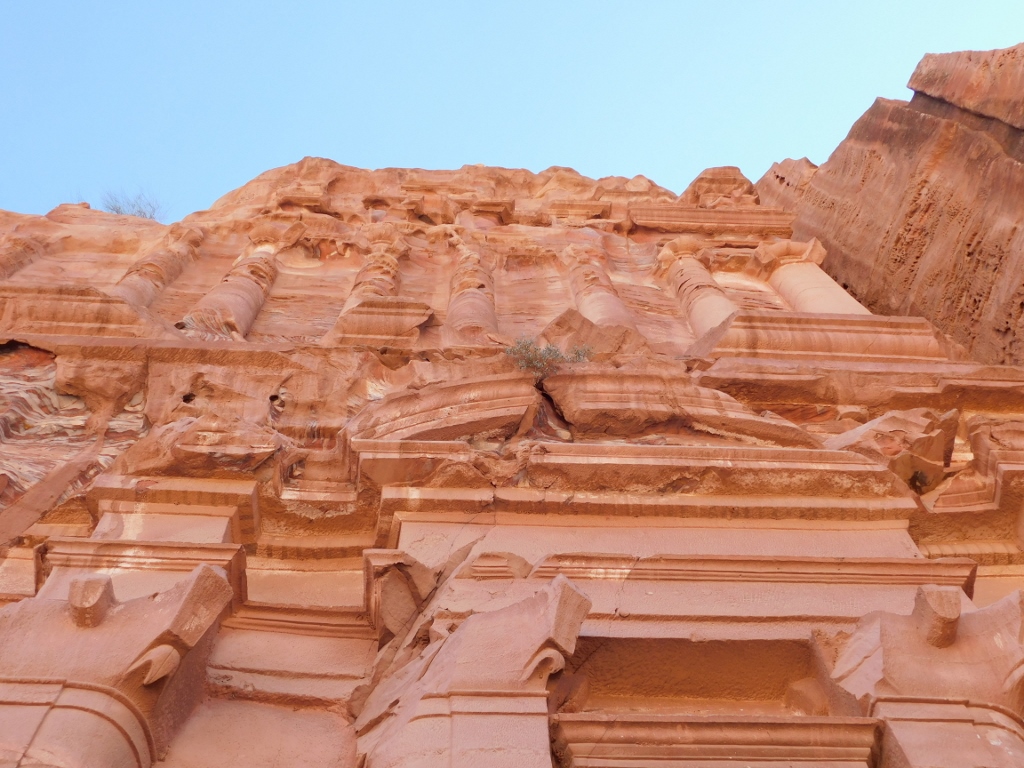 Petra, Palace Tomb, far right section: top of the first zone and the half-columns from the second zone
Petra, Palace Tomb, far right section: top of the first zone and the half-columns from the second zone
The following photo shows the far left section of the Palace Tomb’s facade and there on the top, above the zone with half-columns, it can be seen that the third zone was made of stone blocks.
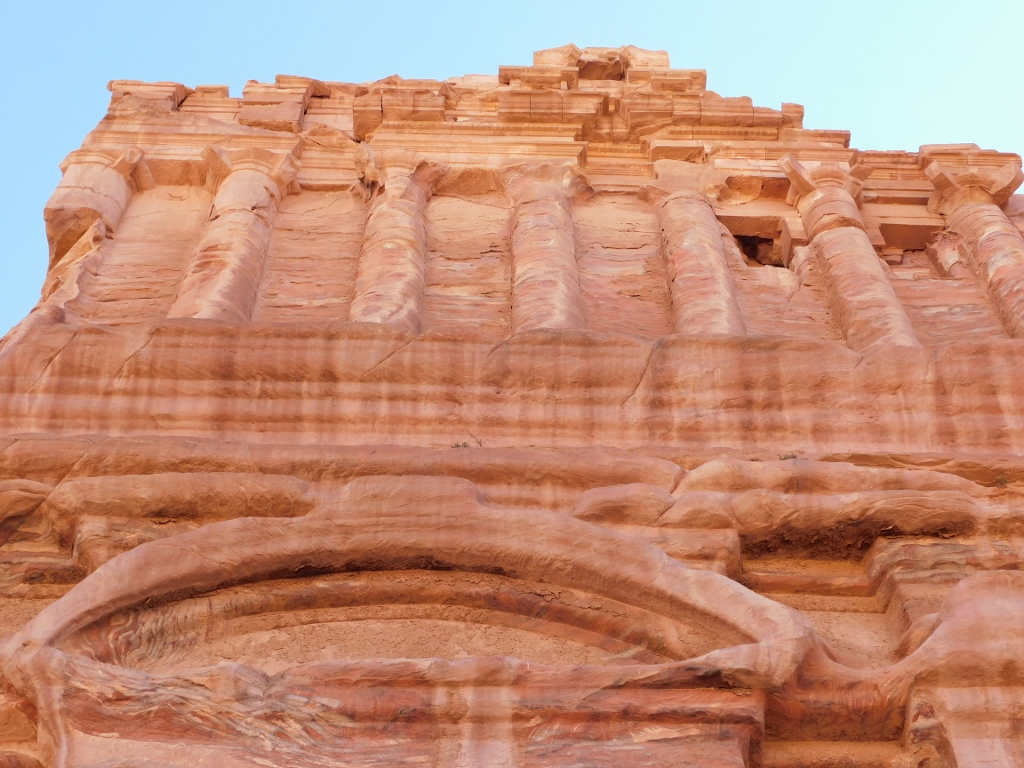 Petra, Palace Tomb, a detail
Petra, Palace Tomb, a detail
Having finished with my sightseeing and taking photos of the Palace Tomb, I continued further, following the Jabal al-Khubtha massif, because I wanted to visit a couple of other tombs made here. In order to do that I had to follow a marked trail, but it was very difficult for walking. It consisted of large stones with very loose sand in-between and that did not feel good to my tired feet. So, I mostly walked alongside the trail, where the ground was more compacted and consequently more solid and more stable for walking.
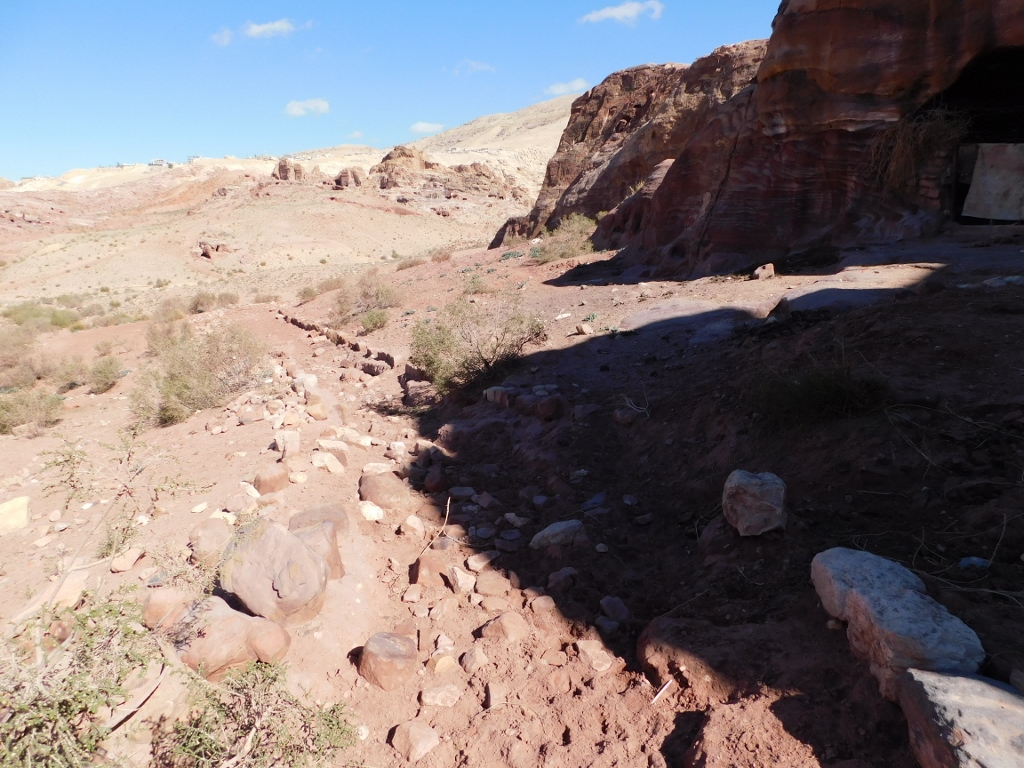 Petra, a detail
Petra, a detail